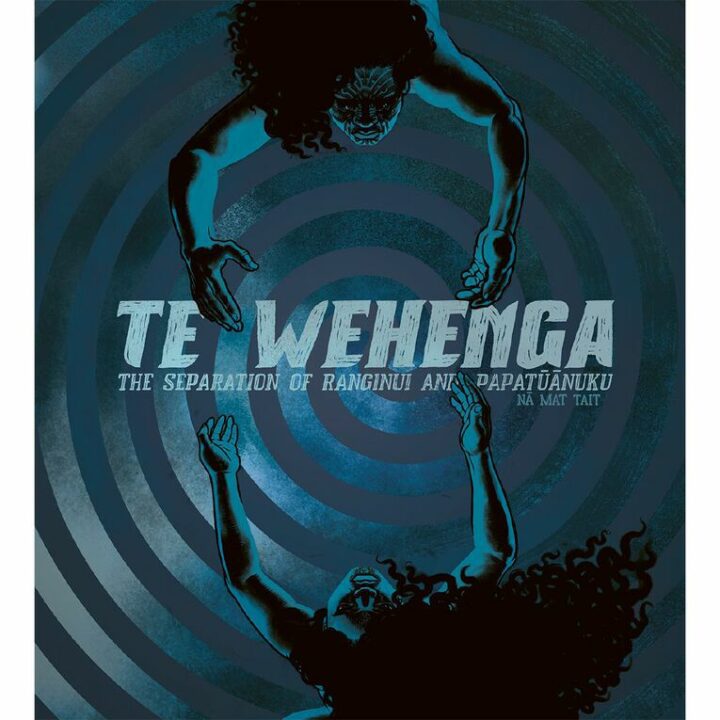Te Wehenga –The Separation of Ranginui and Papatūānuku na Mat Tait

Te Wehenga –The Separation of Ranginui and Papatūānuku na Mat Tait. Allen & Unwin NZ (2022). RRP: $36.99. Hb, 60 pp. ISBN: 9781988547664. Reviewed by S J Mannion.
Te Wehenga The Separation of Ranginui and Papatūānuku is Mat Tait’s second graphic book and is a bold and beautiful thing. It opens bravely with a karakia, to clear the way and to light the path forward. It is a welcoming and gracious piece with all the power of simplicity. And it is untranslated – as is the rest of the text on that and the following page which also closes with a karakia. These pages, they make a statement. There is something almost sacred about the black back with the bright white print. It has the look of a stone tablet, not a gravestone, more a marker or a totem. They set the tone for what is to follow. A book with an austere palette yet an exquisitely sensual visual appeal.
The drawings are a marvel of shade and shape, and they ask more than simply looking, of the reader. So richly drawn and darkly detailed, I found myself picking the book up and tilting it this way and that, bringing it right up to my face, and staring right into the page. Watching how the pages both absorbed and reflected the light. There is a great depth to these drawings – in parts, I was reminded of Ralph Hotere’s masterful Black Paintings, in others, Gordon Walters abstract yet laden lines – they whakapapa to and from both artists, and many and much more.
These pages have a sonic resonance, almost prayer-like and profoundly illustrative. And they are perfect for this most important of Māori myths – The Creation Story. They know and they show how:
‘Mai I te kore ho te pō.’ (p. 5)
And then with subtle and sophisticated insight that:
‘Kei roto I te pō ko te tīmatanga, lo te whanaketanga.’ (p. 8)
This particular creation myth was one I had found difficult to visualise. The idea of the sons of Rangi and Papa, these mighty beings ‘Tane-mahuta, Tawhiri-ma-tea, Tangaroa, Tu-matauenga, Haumia-tikitiki, Rongo-ma-tane’ squashed in between them, like fleas. I simply could not see it and if I cannot see a thing (in my mind’s eye) I cannot understand it. But thanks to the skill and matauranga of Mat Tait, I now not only see it, but feel it, and the rightness of it for the tangata whenua of Aotearoa. It is a powerful and energetic story, of and for, a powerful and energetic people.
The action begins with connection, of course:
‘Ka whātoro atu rāua ki a rāua.’ (p. 12)
And from then on, the illustrator manages to emphasise both the physicality of these Gods, and the intellectual agility, inking the pages with such vigorous, sumptuous detail, it is a palpable glory. The strength of their thighs, (to push apart the sky from the earth). The symmetry of their musculature (straight and strong despite their circumstances). The specific tale of their tā moko (a story written on the body).
It is all so very … finely furious, so vigorously shown, it seems as sure a celebration of the body and also therefore of humanity itself, (for we are as tied to our body as the snail to the shell) as I have yet seen in a graphic novel. This story shows, as all creation myths must show, the seeds of everything that was and is and ever will be. It is a triumph, a taonga, a treasure.
‘Kei roto I te kori ko te Mauri.’